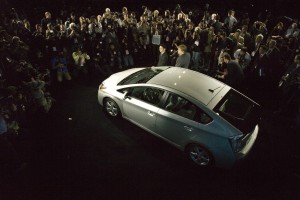How much of a market is there for battery cars and other “green” powertrain technologies?
The answer seems to depend on who you ask and what your basic assumptions about fuel prices are, though there’s little doubt demand for alternative fuel vehicles is growing steadily. But concerns about such issues as rising fuel costs and global warming may not be the biggest motivators, suggests at least one new report. Styling may be equally important.
The current year will be a milestone in the green movement, what with two significant launches scheduled for later this year: the 2011 Chevrolet Volt plug-in hybrid and the pure battery-electric Nissan Leaf. Makers around the world are ramping up production of more conventional green powertrain vehicles, as well, Hyundai, for one, readying its first hybrid-electric vehicle for the U.S. market.
While Volt and Leaf will come too late to make any real impact on the market, a new study by J.D. Power and Associates predicts that global sales of alternative-fuel vehicles will surge a significant 28% this year, “outpacing the 8% growth we expect in light vehicle sales.”
By 2015, the report adds, hybrids and electric vehicles will account for 3 million vehicles annually, or 3.4% of totally global light vehicle demand. The report stresses that basic hybrid-electrics will account for the “majority” of demand.
What motivates buyers to choose a hybrid, battery car or some other alternative fuel offering? Surprisingly, mileage is not the top choice, according to another new study from CNW Marketing.
“One of the critical components in the success” of specific models, says CNW chief Art Spinella, “will be styling.” For those who find that hard to believe compare and contrast the success of the Toyota Prius, the most popular hybrid in the world, with the largely unloved Honda Civic Hybrid, or the smaller maker’s original gas-electric offering, the first-generation, two-seat Honda Insight.
The original Insight was the highest-mileage product offered in the U.S. over the last 25 years, according to a recent report by the Environmental Protection Agency. (Click Here for our report on Top Mileage Misers.) And in real-world driving, according to the EPA, the 2003 to 2005 Civic Hybrid delivered better mileage than the Prius.
“Yet Prius ran away from all other hybrids,” said Spinella, who credits the Toyota sedan’s distinctive styling, which readily told the world just how green-minded its driver was. The Civic Hybrid, on the other hand, was virtually indistinguishable from the conventionally-powered Honda compact.
In a survey of 6,000 mass-market “intenders,” those actively considering the purchase of a new vehicle, 97.3% said the styling of a battery vehicle would influence their choice. By comparison, only 78.6% said the same thing, CNW reports, about fuel economy or range per charge. Quality and interior appearance also rated higher than mileage.
At first blush, suggests Spinella, that might not be all that different from the factors that influence those buying a conventionally-powered vehicle. A similar survey, last year, showed 96.5% listing exterior styling as the critical factor in choosing a new product, with overall quality listed by 94.9%.
But the numbers disguise the fact that, “likely EV buyers are looking for cutting-edge design, (while) conventional-vehicle buyers want ‘nice’ but not over the top.”
One of the biggest surprises, according to the CNW data, is that those buying conventional vehicles actually express more interest in fuel economy than those looking for a green battery car, nearly 88%, compared to 78.6%.
Why? The research suggests EV customers have lower expectations for the products – and will be more likely to use them as secondary, rather than primary, household vehicles. Barely one in nine believe that a battery car could serve their needs on its own.
While “good citizenship” will clearly help drive battery car demand, CNW found, buyers will also want the world to know that with a vehicle that “makes a statement about me.”
But even more importantly, as the first wave of dedicated green buyers and tech fans satisfy their needs, price will become an increasingly critical factor in the alternative fuel market, concludes CNW.
Batteries are expected to remain the most expensive part of electrified vehicles for at least the next decade, according to a variety of industry research, but there are signs that the technology is already dropping a bit. GM insiders tell TheDetroitBureau.com that the lithium-ion cells for the Volt will likely slip to $800 or less per kilowatt hour by the time the vehicle hits market, down from $1,000 a kWh when Volt was first conceived. A recent study by Boston Consulting predicted the number could dip to $400 by 2020, with more optimistic forecasts coming in around $200.

